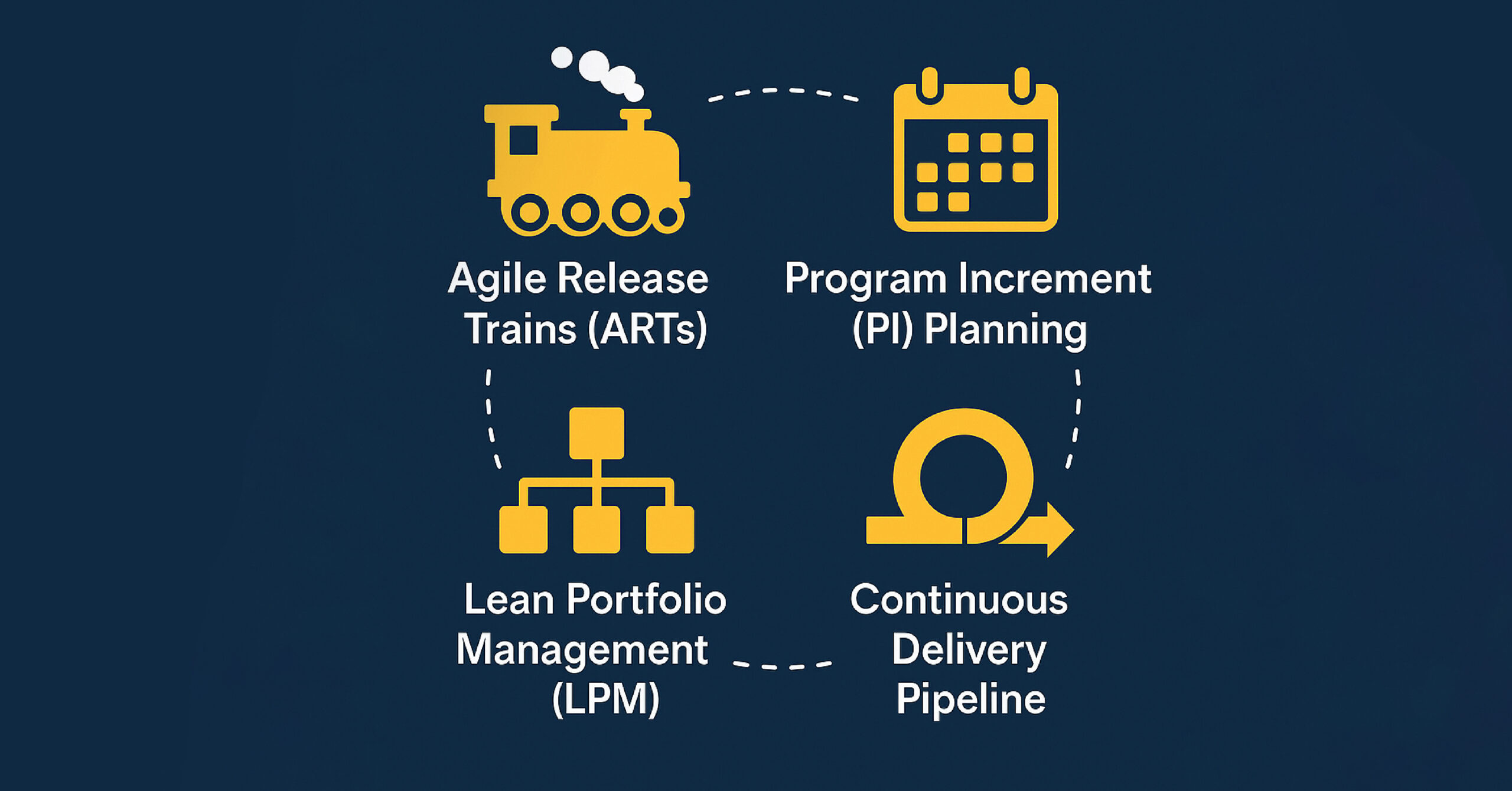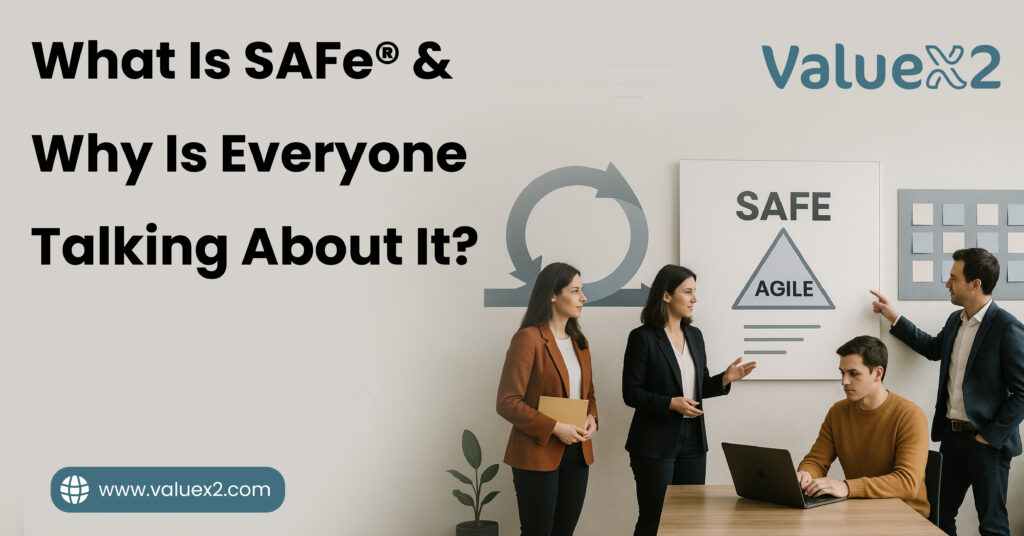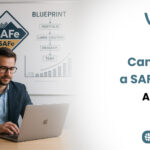Explore what is SAFe® (Scaled Agile Framework). Understand its core values, principles, and practices to scale Agile across your enterprise and deliver value faster and effectively.
Do Agile teams at your company perform well locally, but you can’t notice their good work making a difference for the broader picture? It happens often. It’s easy enough to use Agile with just a few teams, but doing it with lots of teams, each led by a Project Manager towards key objectives?
The reason many people are talking about SAFe® is that it’s a solution focused on solving the complexities of scaling Agile. If you’re ready to learn about what is SAFe® and why so many companies are choosing it for business agility, you’re exactly where you need to be. Let’s explore!
What is SAFe® All About?
So, what is SAFe®? SAFe® helps major organizations introduce Agile methods all over their companies. Just view it as a treasure trove of tested techniques and tips you can use for free. Back in 2011, Dean Leffingwell established the Agile approach.
It isn’t just a current trend. It supports solid concepts such as efficiency from Lean, the speed and flexibility of Agile, seeing the whole picture with systems thinking, and getting development and IT operations to collaborate, also known as DevOps. The combination helps businesses develop better products, provide them faster, and ensure their customers are satisfied.
What’s great about SAFe® is that it adjusts to match different situations. It does not treat each person the same; there’s flexibility built in. It gives you several options or configurations to handle the size and complexity of your organization.
- Essential SAFe®: The starting point, giving you the basics for teams (called Agile Release Trains) to deliver solutions.
- Large Solution SAFe®: For companies building really big, complex things that need several teams and suppliers working together.
- Portfolio SAFe®: This level connects your company’s big strategy with the actual work getting done. It brings in Agile Portfolio Management (APM).
- Full SAFe®: The whole package, mixing all the levels to help build and manage huge, interconnected solutions.
Why’s Everyone Choosing SAFe®?
The buzz around SAFe® is there for a reason – it brings some serious benefits:
- Get Products Out Faster (Accelerated Time-to-Market): SAFe® helps line up teams on what they call Agile Release Trains (ARTs) and pushes for a Continuous Delivery Pipeline. This means getting valuable stuff to customers quicker. For example, AstraZeneca IT reported getting things done 40-60% faster with SAFe®.
- Get More Done (Boosted Productivity): When teams are on the same page, and roadblocks clear up, they can do more. SAFe® helps the workflow better, leading to higher productivity.
- Better Quality Products (Enhanced Quality): Built-in quality is a big deal in SAFe®. It means making quality part of the process from day one, not an afterthought. Cisco, using SAFe®, saw a 14% improvement in finding defects early.
- More Reliable Delivery (Improved Predictability): Businesses need to know what to expect. SAFe® has big planning sessions like SAFe® PI Planning (Program Increment Planning) that get everyone aligned. This leads to more dependable delivery.
- Happier, More Engaged Employees (Increased Employee Engagement & Job Satisfaction): SAFe® gives people clear roles and empowers teams. A 2025 “State of SAFe Report” by Scaled Agile found that 68% of companies saw employee satisfaction go up after bringing in SAFe®.
- Real Company Agility (Business Agility): All these perks add up to your company being able to react quickly to market changes and grab new opportunities.
Key Components of SAFe® You Should Know

SAFe® has a few main parts that work together to make big-company agility happen:
- Agile Release Trains (ARTs): An Agile Release Train (ART) is created by collecting around 50-125 individuals into one team to work, plan, and release together. They’re the engine of SAFe®.
- Program Increment (PI) Planning: Program Increment (PI) Planning marks a formal SAFe® gathering each program cycle. Usually, on ART, everyone comes together for two days to discuss and decide what needs to be done next over the following 8-12 weeks. It supports consistent delivery every time.
- Lean Portfolio Management (LPM): LPM focuses on ensuring the company is focused on the right things and that its work supports the company’s strategy. Doing this is necessary for a successful SAFe® implementation.
- Continuous Delivery Pipeline: Continuous Delivery Pipeline relates to how an idea makes its way into customer value, with as little friction and as quickly as possible.
- SAFe® Core Values: The four values that guide SAFe® are Alignment, Built-in Quality, Transparency, and Program Execution. Leadership calls attention to the role good leaders play in making any change in Agile work better.
Who’s Using SAFe®? (And Is It For You?)
SAFe® is mostly for bigger companies dealing with complex projects and many teams. If your company has lots of Agile teams that find it hard to work together, deliver on time, or connect with the main business goals, SAFe® could be worth a look.
You’ll find it in all sorts of industries:
- IT and Software
- Banking and Finance
- Healthcare (like Philips)
- Car Manufacturing (like Porsche)
- Government
The common theme? They all need to handle complexity, improve collaboration across departments, and speed things up.
Heads Up: Potential Bumps in the SAFe® Road
No system is perfect, and SAFe® has its challenges:
- Can Feel a Bit Rigid: Some find SAFe® too structured, worrying it might limit team freedom if followed too strictly.
- “SAFe® in Name Only”: Just doing the SAFe® activities without truly adopting the Agile mindset won’t get you the real benefits. This is also known as SAFe-INO.
- It’s a Lot to Learn: SAFe® is big, and getting everyone up to speed takes time and effort. SAFe® implementation challenges are real.
- Leaders Must Be On Board: A SAFe® transformation needs strong support from the top.
Success with SAFe® means knowing these hurdles and planning for them.
Is SAFe® the Best Way to Improve Your Organization?

Is SAFe® making its way into your business? Talk to yourself by asking these questions:
- Do you find your teams find it difficult to collaborate on big objectives?
- Does consistent pressure come from always being behind schedule when delivering large projects?
- Do departments need to form better partnerships with one another?
- Is your business sluggish about responding to changes in the market?
If your answer is “yes,” then you might want to consider SAFe®.
Wrapping Up
Now that you have learned what is safe, it is important for any business to move fast, adapt, and put the customer first. For large organizations, efficient scaling of Agile is no longer just optional; it’s mandatory. SAFe® has become a leading way to do this by offering a thorough and flexible guide. Ready to unlock your potential and lead impactful transformations? Explore ValueX2’s comprehensive range of SAFe certifications and empower yourself with the knowledge and skills to drive enterprise agility.
It takes work, a new way of thinking, and real commitment. But the payoff – getting to market faster, better quality, more productive teams, and true business agility – is why so many companies are talking about and using the Scaled Agile Framework®. For many, SAFe® offers a clear path to achieving enterprise-scale agility and winning in the modern business world.



